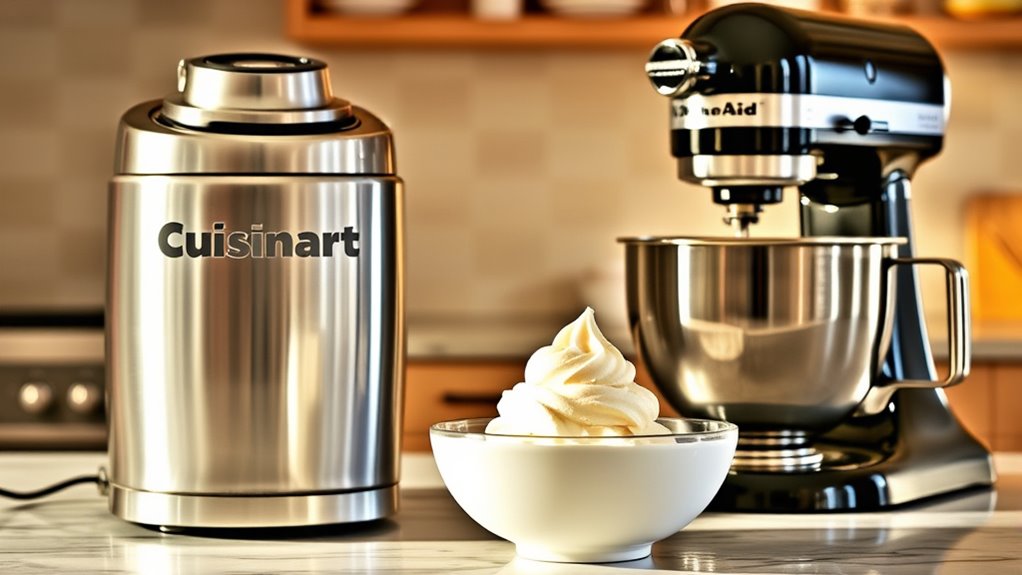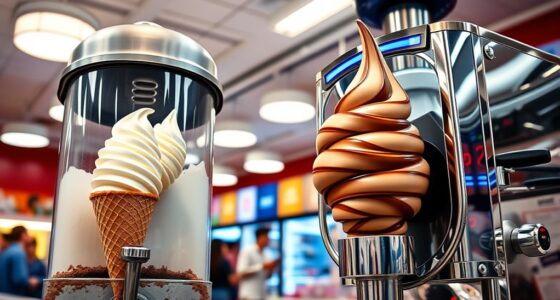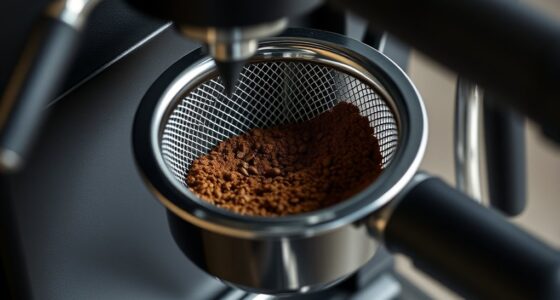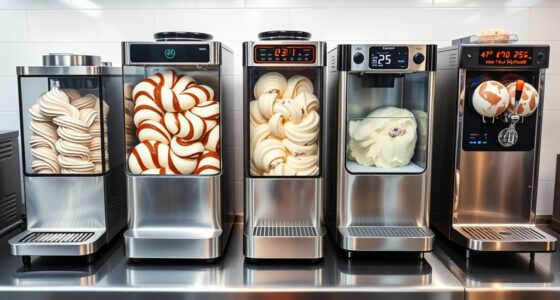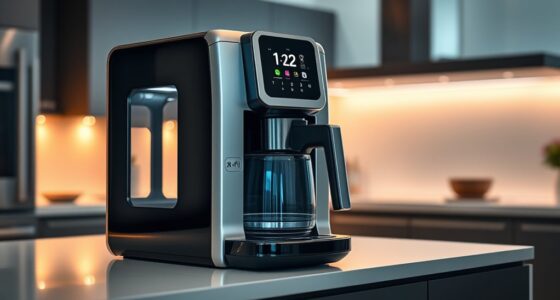If you want consistently perfect ice cream, Cuisinart’s built-in compressor models are the way to go since they offer quick, effortless results without pre-freezing bowls. KitchenAid, though versatile, relies on pre-chilled bowls, requiring more planning and time. Each brand has its strengths, but for fuss-free, high-quality frozen treats, Cuisinart often stands out. Keep exploring — you’ll find tips that can help you make restaurant-quality ice cream at home.
Key Takeaways
- Cuisinart’s built-in compressor ensures continuous, hassle-free ice cream making without pre-freezing, often resulting in more consistently perfect textures.
- KitchenAid offers versatile attachments and recipes, but requires pre-chilled bowls, which may affect the ease of achieving perfect ice cream.
- Cuisinart models deliver quick, creamy results with minimal prep, making them ideal for consistently high-quality ice cream.
- KitchenAid’s flexibility in recipes and textures depends on proper pre-freezing and handling, which can impact the perfection of the final product.
- Overall, Cuisinart’s compressor-based design provides a more reliable, hands-off approach for consistently perfect ice cream.
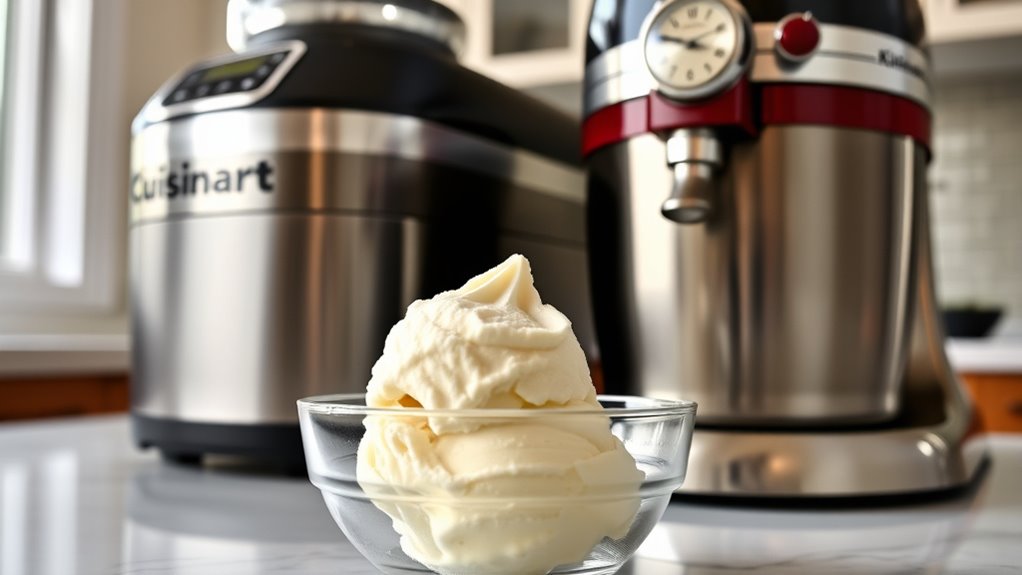
When choosing between Cuisinart and KitchenAid ice cream makers, you want a machine that delivers quality results without hassle. They often come with built-in compressors, meaning you don’t need to pre-freeze bowls, saving you prep time. When trying out various dessert recipes—from classic vanilla ice cream to more inventive flavors—you’ll appreciate how quickly Cuisinart machines churn out creamy textures, even with complex ingredients. Their intuitive controls simplify the process, making it straightforward for both beginners and seasoned home chefs. Plus, because most models require minimal prep, you spend less time on appliance maintenance and more on perfecting your dessert creations.
In contrast, KitchenAid ice cream makers typically rely on a frozen bowl that needs to be pre-chilled before use. While this might seem like an extra step, it also means you’ll be familiar with appliance maintenance routines—like keeping spare bowls in the freezer for quick assembly. If you enjoy experimenting with different dessert recipes, such as sorbets, gelatos, or frozen yogurts, KitchenAid’s versatile attachments let you customize textures and flavors. However, the pre-freezing requirement means planning ahead, especially if you want to whip up multiple batches in a short time. Cleaning and maintaining the appliance involves more attention since you need to ensure the bowls are thoroughly frozen and free of debris, but once set up, it’s reliable for producing high-quality frozen treats. Additionally, proper maintenance can significantly extend the lifespan of your appliance and keep it functioning optimally. Regularly checking product performance through routine inspections can help identify potential issues before they affect your desserts.
Both brands hold up well over time, but their maintenance needs vary. Cuisinart models with built-in compressors generally require less ongoing care, making them more convenient if you want a “set it and forget it” approach. Meanwhile, KitchenAid’s removable bowls mean you’ll need to handle freezing and cleaning more carefully, but they give you the flexibility to make large batches or different dessert recipes without waiting for the internal compressor to cycle. Additionally, foraging techniques can be useful if you want to incorporate fresh ingredients into your recipes or explore natural flavorings. Proper cleaning and upkeep are essential for maintaining optimal performance and ensuring your machine lasts for years. Ultimately, your decision hinges on how much effort you’re willing to invest in appliance maintenance and what kind of dessert recipes you plan to explore most frequently. If speedy results and minimal upkeep are your priorities, Cuisinart might be your best bet. If you prefer a more traditional approach with the flexibility to experiment, KitchenAid’s design could suit you better.
Frequently Asked Questions
Which Brand Offers Better Durability Overall?
You’re wondering which brand offers better durability overall. Based on a durability comparison and material quality assessment, Kitchenaid tends to use sturdier, more resilient materials, making their appliances last longer under regular use. Cuisinart products often feature good build quality but may not withstand heavy, repeated use as well. If longevity matters most to you, Kitchenaid generally provides more durable options for your kitchen needs.
Are Replacement Parts Easily Accessible for Both Brands?
Finding replacement parts for your appliance is like hunting for hidden treasure. Luckily, both brands offer good availability of accessories and replacement parts, making repairs a breeze. Kitchenaid generally has a wider network for parts, but Cuisinart also provides accessible options through their customer service. You won’t be left stranded when something needs fixing, ensuring your appliance stays in top shape for years to come.
Which Machine Is More Energy-Efficient?
When considering which machine is more energy-efficient, you should look at energy consumption and power efficiency. Generally, models with lower wattage use less electricity and are more cost-effective over time. Check the specifications for each machine’s power usage—those with smarter motor design and better insulation tend to be more power-efficient. Choosing a machine that minimizes energy consumption helps you save money and reduces your environmental impact.
Can These Machines Make Other Frozen Desserts?
You can definitely use these machines to make other frozen desserts like frozen yogurt and sorbet recipes. They’re versatile and work well with different ingredients, allowing you to experiment with various flavors and textures. Just follow your preferred recipes, and you’ll get smooth, delicious results every time. Whether you’re craving a creamy frozen yogurt or a invigorating sorbet, these machines are up to the task.
What Is the Warranty Coverage for Each Brand?
You should check each brand’s warranty policies to understand what’s covered and for how long. Cuisinart typically offers a 3-year warranty on their appliances, while Kitchenaid also provides similar coverage, often around 1-5 years depending on the product. Both brands are known for solid customer support, so if you encounter issues, reaching out should be straightforward. Always review the specific warranty details before purchasing to ascertain peace of mind.
Conclusion
In the end, Cuisinart and KitchenAid each bring unique strengths to your ice cream adventures. While Cuisinart offers quick, creamy results with ease, KitchenAid shines with versatility and craftsmanship. Think of Cuisinart as your speedy friend in a rush, whipping up perfection in minutes, whereas KitchenAid is your reliable partner, delivering rich textures with every batch. Your choice depends on whether you crave speed or craftsmanship—either way, only one truly makes perfect ice cream.
